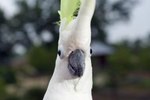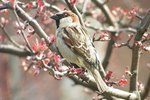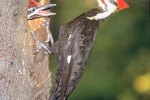
Sri Lanka's Sinharaja forest reserve is the country's last region of prime tropical rain forest and home to a significant percentage of Sri Lanka's endemic flora and fauna species. Describing a species as endemic means that it is native to a country or specific habitat and that you won't find it anywhere else. In 1988 UNESCO declared Sinharaja a world heritage site; this status reflects the importance of the rain forest and its inhabitants.
Endemic Bird Species
Sinharaja is home to 21 endemic bird species.The Layard's parakeet, the Junglefowl and Spurfowl are among the forest reserve's more populous indigenous species. Other endemic bird species of note are the Ceylon hanging parrot, the Ceylon gray hornbill, the Ashy-headed laughing thrush and the Red-faced malkoha, as well as the Brown-capped babbler and the Blue magpie.
The Ceylon Bird Club points out that the survival of these endemic species is important because they have distinct characteristics. Some of the species may originate in neighboring India, but the long separation of the island from the main land mass has allowed the birds to develop unique characteristics. The organization also suggests that some bird species are descendents of Indian species that no longer exist, and this adds to the scientific significance of their survival.
Endangered Endemic Birds
Degradation of the rain forest through logging and agricultural usage, such as clearing areas for tea and palm oil plantations, threatens the survival of five endemic bird species: the Sri Lankan wood pigeon, Green billed coucal, Sri Lankan white-headed starling, the Ashy-headed babbler and the Sri Lankan blue magpie.
The Green-billed coucal, for example, is listed as "vulnerable" on the International Union for Conservation of Nature's Red List . This particular species' survival has been threatened since 1994 due to the aforementioned human activities in his habitat. These activities affect all the bird species, but the IUCN also reports that this particular bird is poor at adapting to any changes in his habitat. A reduced food supply threatens the Sri Lanka wood pigeon's survival prospects. He likes to feed on fruit trees, and moves around a wide area of forest to find the right ones, but many of his trees have been replaced by single crop plantations.
Effects of Change
Problems with adapting to environmental change is an issue for some of the other bird species. This is particularly true of those endemic birds that live within a restricted range. For example, the Red-faced malkoha lives in the upper canopy of the rain forest. According to Birdlife International this species population has been badly affected by selective logging because he only survives in dense forest canopy. By contrast the Ashy-headed laughing thrush population seems to have benefited from selective logging. This is because he loves gaps in the forest canopy.
Community Threats to Sinharaja
Sinharaja's endemic bird species also face the fact that local communities also depend on the forest for survival. Villagers collect jaggery, a form of sugar harvested from palm trees. Jaggery plays an important role in Indian and Sri Lankan cooking, and is a source of income for local people. They also collect firewood. Indeed, about eight percent of the local community are completely dependent on the rain forest for their survival, while the others depend on it to varying degrees. Conservationists aim to reduce this dependence on the rain forest and introduce more sustainable livelihood projects.
References
- UNESCO: Sinharaja Forest Reserve
- Rainforest Rescue: Sri Lanka's Sinharaja Rainforest Corridor
- Sinharaja: World Heritage Rainforest
- Birdlife International: Ashy-Headed Laughing Thrush
- Ceylon Bird Club: Birds of Sri Lanka
- IUCN Red List: Green-Billed Coucal
- Birdlife International: Sri Lanka Endemic Birds
- Birdlife International: Sri Lanka Wood Pigeon
- Birdlife International: Red-Faced Malkoha
Photo Credits
-
Ablestock.com/AbleStock.com/Getty Images
Writer Bio
Based in London, Eleanor McKenzie has been writing lifestyle-related books and articles since 1998. Her articles have appeared in the "Palm Beach Times" and she is the author of numerous books published by Hamlyn U.K., including "Healing Reiki" and "Pilates System." She holds a Master of Arts in informational studies from London University.




